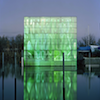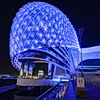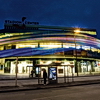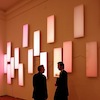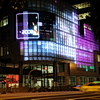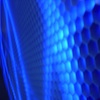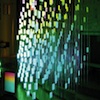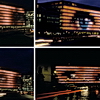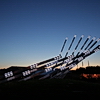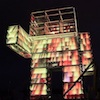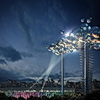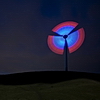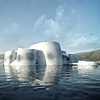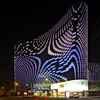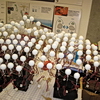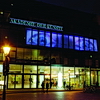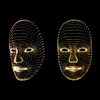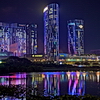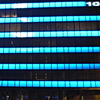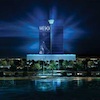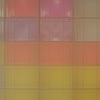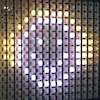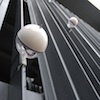Biennale 2010 Exhibition
The main objective of the exhibition is to represent the state of the art in Media Architecture. We cover a broader range of projects that have one or more of the following features:
- They form a combination of Architecture (physical spatial structure) with Media (Imagery produced on the surface or within the structure of an architecture).
- Media content forms a central part of the project. It is mostly displayed by a rather large number of integrated light sources (and in some cases also by kinetic elements).
- Content is electronically produced.
- Content is in many cases not abstract but readable or “watchable” and creates a dialogue between the building and the spectator
- In many projects the installation provides different forms of interaction which allow inhabitants to influence the content or or even upload user-generated media, such as imagery or text.
- Most of these projects are highly relevant for cityscape and urban atmosphere.
The exhibit will cover a range of about 40 projects, which will be documented or produced in the form of prototypes, models and large-size pictures. Our goal is to present media architecture in an appropriate way. Therefore, we will place an interactive piece of media architecture, the installation „Boxels“, in the center of the exhibit, which will function as a space for artistic projection, as well as a point of information about project details. Visitors can take an iPad-based interactive guide that forms part of the installation, into the exhibition in order to get more detailed descriptions, photos and videos about a project. On display are projects by the following offices: UNStudio, realities:united, Adam Somlai-Fischer, Asymptote Architecture, Peter Cook, Herzog & de Meuron, Gramazio&Kohler Architecture, ETH Zurich – horao, Lab[au], Traxon e:cue, Zumtobel, Citiled, ag4 / GKD, and many, many more.
The exhibited projects are related to the below mentioned categories:
Animated Architecture
The facade of the buildings are animated by integrated light-sources. Architecture and the perception of the building is in the focus of the designers. The flexibility of content is rather limited due to resolution, colour and shape of the pixels. In most cases the pixels are highly customized and form the creative challenge of the project.
Money Architecture
Buildings that are strongly related to Business, Banks, Shopping, Entertainment and Gambling. Light on the building surface is to attract people and make them spend money or as in the case of banks represents the power of the building owner.
Social-Media-Architecture
Projects mostly developed by Media Designer that allow passers-by to interact with and take control of the content on the surface. Many projects are non-permanent and built on an pre-existing architectural structure. New media formats taking advantage of mobile apps are being developed.
Spatial Media Art
Projects produced in an artistic context at the intersection of architecture and media art. Mostly non-permanent movable installations with an innovative form of spatial interaction and/or perception of space.
Future Trends and Prototypes
This sections covers special solutions like three dimensional displays, kinetic facades or OLEDs that shed a light on how future media architectures might look like.
Exhibition Curators:
- Gernot Tscherteu
- Martin Tomitsch
See the whole team [here].
Projects shown:
KPN Tower, Star Place, Wilkie Edge – Aamp, Singapore 2009 , City of Dreams, UEC Iluma – Crystal Mesh, Nordwesthaus Rohner, Volketswil Bauarena, African Pavillon Expo 2008, Galleria Store, The Yas Hotel, National Library, Allianz Arena, Kunsthaus – BIX, The Chanel Ginza Tower, AEC Linz, 2008, Stern des Südens – Project Hope, Indemann 2009, fLUX – binary waves, The World’s Largest Time Piece, Nova, Portable/Deflatable LED Matrix, Distributed Projection Structure 2004, The Thor Heyerdahl Globe, TEXLON® flexipix, Stadion Center, Grand Lisboa, La Porte Shinsaibashi, UNIQA Tower, UNIQA headquarters, King’s Road Tower, Mediamesh® Milan, Marnix 2000, Blinkenlights, Dexia Tower, The Cloud, London 2012 , boxLEDs, Dynamic Ornament, One Ocean – Thematic Pavilion Expo 2012, GreenPix – Zero Energy Media Wall, Polymedia Pixel – 3d display, C4 Espacio de Creación Artística Contemporánea, Solar Collector – www.solarcollector.ca, Urban Pixels, Neuroled, Luma Space 2010, Flyfire, FLARE Facade, Electric signs – vox pop
Institutions, ateliers, and persons participating:
aether architecture, ag4 media facade GmbH/GKD, Alex Haw, Arup, Arquitectonica, Asymptote Architecture, ATELIER BRÜCKNER GmbH, Baumschlager Eberle, Blinkenlights, Citiled, e:cue, ETH Zurich – horao GmbH, Freimüller Söllinger Architektur ZT, Gramazio & Kohler, Gorbet Design Inc., Herzog & de Meuron, Komaden Corporation, LAb[au], Lighting Science Design Works, Lisa Autogena and Joshua Portway with SmartSlab™, Magic Monkey, Manfred Wuits, Maurer United Architects, Michael Pendry, MIT Media Lab (Susanne Seitinger, Danny Perry) with Distance Lab (Richard Wilson), Neumann und Partner, Nieto Sobejano Arquitectos, Nüesch & Partner Architekten, Peter Cook, Peter Marino Architect, Plantec Architects Inc., realities:united, Renzo Piano, Rogier van der Heide in cooperation with Dick Vonk and students of the Amsterdam University of Applied Sciences, SENSEable City Lab with ARES Lab, Simone Giostra & Partners, soma, StandardVision LLC, Traxon Technologies, Treusch architecture ZT GmbH, UNStudio, UrbanAid group and SenseAware Lab / University of Technology, Sydney, Vector Foiltec, Victor Karmaenko, WHITEvoid interactive art & design, Wilke Technology GmbH, WOHA Architects, Zumtobel.







